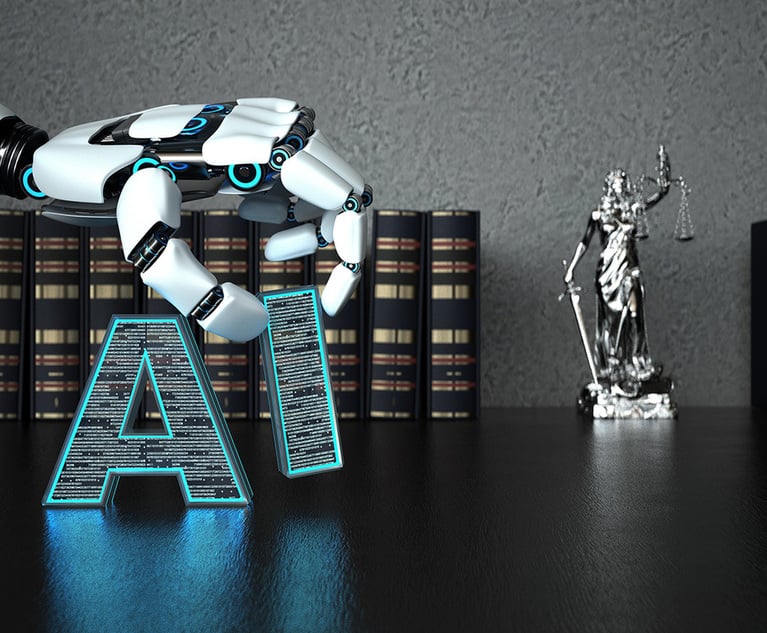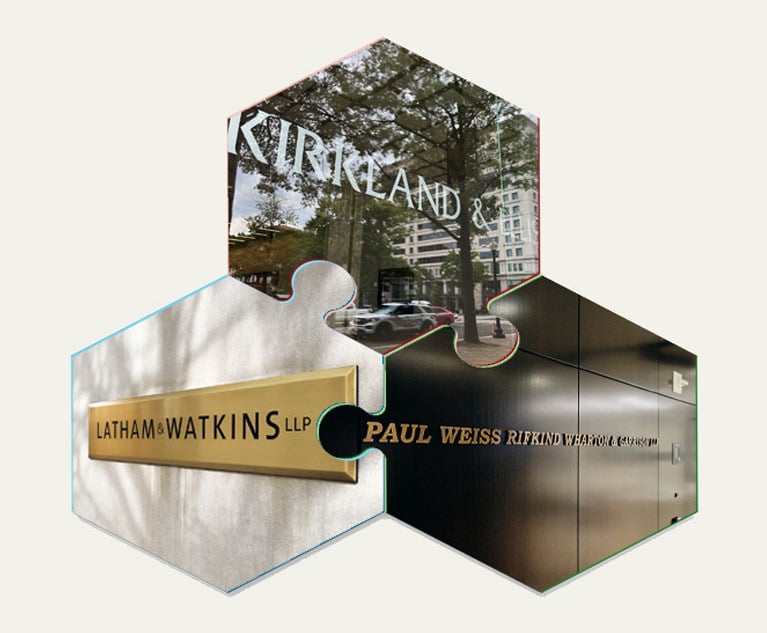Reinventing Your Law Firm: If Not Now, When?
As the demand for legal services lessens, supply will increase, leaving lawyers and law firms that lack strong positioning and differentiation struggling to overcome perceptions that they're offering nothing more than a commodity.
April 30, 2020 at 10:55 AM
8 minute read
The original version of this story was published on The American Lawyer
 Credit: MJgraphics/Shutterstock
Credit: MJgraphics/Shutterstock
During the last decade, countless predictions were made about the coming age of innovation in the legal industry, but there was only marginal, incremental change. As Danish physicist Neil Bohrs once said, "Prediction is very difficult, especially if it's about the future."
Something no one predicted is that it would take a global pandemic to finally usher in an era of actual innovation—that is, implementing change, not merely talking about it. Law firms have been forced to change more in the past six weeks than in the previous 10 years combined. Innovation has always been one of those loose, difficult-to-define words, but now we're getting a taste of what it really means. Nothing awakens necessity more than a crisis.
Law firms are now beginning to look beyond the urgency and immediacy of the onset of this crisis, and trying to assess what comes next. It seems all but certain that any hope of a "V-shaped" recovery, ushering in a swift return to the "old normal," is wishful thinking. We are moving past the beginning but are nowhere near the end. We are in a liminal space, which is a transitional time between what was and what is next.
Author Richard Rohr describes a liminal space (the word "liminal" is derived from the Latin word "limen," meaning threshold) as: "Where we are betwixt and between the familiar and the completely unknown. There alone is our old world left behind, while we are not yet sure of the new existence. That's a good space where genuine newness can begin."
Law firms have a choice. One option is to wait it out—taking small, middling measures—until things go back to the old way. Another, which recognizes we are at the threshold to a future that will look nothing like the past, is to lean into the current crisis and invent a new way of doing business that adapts to and addresses the evolving needs of the marketplace.
This liminal moment is a time for focused strategy and rapid execution. One of the unexpected consequences of the current crisis is that some of the winners that emerge on the other side will be those who are feeling the pain most acutely at this moment. A crisis is a forcing function. Many of those who have strong financial means may simply hunker down. Those who are struggling, for whom the status quo is intolerable, will be forced to invent and innovate.
While predicting the future is impossible, it is incumbent upon law firm leaders to do their best to forecast what is coming next. Many practical changes have been made to adapt to near-term circumstances. What's being missed is that many cultural changes, which will significantly impact market dynamics moving forward, are likely irreversible. From how and where people work, to changes in client buying behaviors, there is no going back to the pre-COVID-19 status quo.
While the "punch list" of issues that law firm leaders must address right now is a mile long, there are certain important, fundamental themes that future-focused leaders should be considering while making decisions. Keep in mind that—and this is important—these themes relate to existing trends that are being deepened and accelerated by the pandemic, not necessarily created by it. Therefore, failure to adapt in hopes of returning to the status quo will result in a step back, not merely standing still.
Remote Work: In short, it's working—at least well enough that firms should be considering making what was seen as a temporary arrangement a more permanent one. As many firms that previously dispersed their workforces have already come to realize, lawyers are capable or serving their clients from home offices, and clients are more or less agnostic as to where work is being done as long as it's getting done at a satisfactory level of quality. Just as more health care will be administered virtually via telehealth moving forward, more legal work will be conducted via "telelaw."
Does that mean there will be universal conversion from on-site to virtual in the legal industry? Of course not. But virtual, or at least virtual-ish, will become a more prominent working model for many law firms due to financial considerations, workforce preferences, and client indifference as to whether a lawyer is working from her office or her kitchen table. Firms that rigidly intend to return to co-located work should re-examine their beliefs about the necessity and benefits of having everyone working under one roof. After all, even though remote is not perfect, your firm and your lawyers will only get better at it with more practice.
Real Estate: One of the major implications of a shift to virtual work will be a reassessment of the investment in real estate—from owned buildings to leased office space—that many firms allocate large amounts of their annual budgets toward. Firms, especially in big cities, tend to opt for "Class A" office space at top-of-market rates, and often lease or buy more space than they need to accommodate for expected growth. Their fixed real estate costs hamper their ability to invest in innovative solutions that can grow their business. In the future, firms may decide that an office is better recast as a place to meet clients and host critical infrastructure operations, while lawyers operate independent of any spatial constraints.
Systems and Processes: Many law firms operate as an eclectic group of practices and individuals, each with its own idea of the best way to serve clients, manage projects and develop new business. They're loosely bound together under the banner of a law firm's brand, but lack systems and processes that result in consistent work product and predictable client experiences. It's long been said that law firms need to run more like entrepreneurial enterprises, with dialed-in strategies, systems and processes that dictate how work gets done, but that call to action has largely been ignored.
As you contemplate how your firm can be best positioned to emerge stronger from the crisis, consider how the lack of systems and processes hamper the optimal performance of various functions within your firm. How can your teams communicate better? Do you lack consistent efforts in marketing and business development? Is timekeeping being captured? Are collections lagging? Are you improving your talent through professional development training? Too often, these and other issues are dealt with, if at all, with an ad hoc approach instead of a strategic one based on clear, consistent systems and processes that ensure accountability.
Hollywood Model: In terms of trends deepening and accelerating due to the COVID-19 crisis, one that is almost certain to pick up pace is corporate clients looking for the right expert for a particular job, rather than relying on one law firm as a one-stop shop. Sophisticated clients are increasingly viewing the delivery of legal services as part of a supply chain, and plugging in the right resources at each tier to satisfy their demand for specialized expertise. No longer is a lawyer (or a law firm) being relied upon to handle all aspects of legal matters. What used to be the job of a lawyer is now seen as a series of discrete tasks—many of which can be handled by alternative legal service providers and/or software algorithms.
To adapt, law firms need to accelerate their adaptation toward more nimble, flexible work arrangements, such as the so-called "Hollywood model." In Hollywood productions, a producer assembles a team to work on a project and the team works together for as long as is necessary to complete the project. The Hollywood model allows organizations to scale up or down to meet demand. For law firms, this means relying less on fully-staffed, fixed-cost teams, and instead assembling teams based on the specific needs of a project. To accomplish this, firms will need to embrace more of a Hollywood model approach, maintaining a solid core while bringing in experts on a temporary basis to perform discrete functions, rather than being fully staffed for every eventuality.
If Not Now, When?
There are other themes that will deepen and accelerate trends in the legal marketplace. As the economy continues to weaken, there will be churn in corporate legal departments, leading to fractured relationships and opportunities for non-incumbents. As the demand for legal services lessens, supply will increase, leaving lawyers and law firms that lack strong positioning and differentiation struggling to overcome perceptions that they're offering nothing more than a commodity. The number of innovations that can be hatched to address these and other developments is limited only by a law firm's dedication to strategic thinking.
The task ahead feels immense. But as with any difficult task, the only way to approach it is one step at a time. After all, if not now, when?
Jay Harrington is a lawyer, author, business coach and consultant to leading lawyers and law firms. He is the president of Harrington Communications, a top thought-leadership marketing agency serving a nationwide clientele of law firms. He can be reached at [email protected].
This content has been archived. It is available through our partners, LexisNexis® and Bloomberg Law.
To view this content, please continue to their sites.
Not a Lexis Subscriber?
Subscribe Now
Not a Bloomberg Law Subscriber?
Subscribe Now
NOT FOR REPRINT
© 2025 ALM Global, LLC, All Rights Reserved. Request academic re-use from www.copyright.com. All other uses, submit a request to [email protected]. For more information visit Asset & Logo Licensing.
You Might Like
View All
DeepSeek’s AI Power Move: Will Lawyers Be the Next to Adapt or Perish?
6 minute read
Now That the Trump Era Has Begun, Change Is Coming. For Big Law, Change Is Already Here
6 minute readTrending Stories
- 1Uber Files RICO Suit Against Plaintiff-Side Firms Alleging Fraudulent Injury Claims
- 2The Law Firm Disrupted: Scrutinizing the Elephant More Than the Mouse
- 3Inherent Diminished Value Damages Unavailable to 3rd-Party Claimants, Court Says
- 4Pa. Defense Firm Sued by Client Over Ex-Eagles Player's $43.5M Med Mal Win
- 5Losses Mount at Morris Manning, but Departing Ex-Chair Stays Bullish About His Old Firm's Future
Who Got The Work
J. Brugh Lower of Gibbons has entered an appearance for industrial equipment supplier Devco Corporation in a pending trademark infringement lawsuit. The suit, accusing the defendant of selling knock-off Graco products, was filed Dec. 18 in New Jersey District Court by Rivkin Radler on behalf of Graco Inc. and Graco Minnesota. The case, assigned to U.S. District Judge Zahid N. Quraishi, is 3:24-cv-11294, Graco Inc. et al v. Devco Corporation.
Who Got The Work
Rebecca Maller-Stein and Kent A. Yalowitz of Arnold & Porter Kaye Scholer have entered their appearances for Hanaco Venture Capital and its executives, Lior Prosor and David Frankel, in a pending securities lawsuit. The action, filed on Dec. 24 in New York Southern District Court by Zell, Aron & Co. on behalf of Goldeneye Advisors, accuses the defendants of negligently and fraudulently managing the plaintiff's $1 million investment. The case, assigned to U.S. District Judge Vernon S. Broderick, is 1:24-cv-09918, Goldeneye Advisors, LLC v. Hanaco Venture Capital, Ltd. et al.
Who Got The Work
Attorneys from A&O Shearman has stepped in as defense counsel for Toronto-Dominion Bank and other defendants in a pending securities class action. The suit, filed Dec. 11 in New York Southern District Court by Bleichmar Fonti & Auld, accuses the defendants of concealing the bank's 'pervasive' deficiencies in regards to its compliance with the Bank Secrecy Act and the quality of its anti-money laundering controls. The case, assigned to U.S. District Judge Arun Subramanian, is 1:24-cv-09445, Gonzalez v. The Toronto-Dominion Bank et al.
Who Got The Work
Crown Castle International, a Pennsylvania company providing shared communications infrastructure, has turned to Luke D. Wolf of Gordon Rees Scully Mansukhani to fend off a pending breach-of-contract lawsuit. The court action, filed Nov. 25 in Michigan Eastern District Court by Hooper Hathaway PC on behalf of The Town Residences LLC, accuses Crown Castle of failing to transfer approximately $30,000 in utility payments from T-Mobile in breach of a roof-top lease and assignment agreement. The case, assigned to U.S. District Judge Susan K. Declercq, is 2:24-cv-13131, The Town Residences LLC v. T-Mobile US, Inc. et al.
Who Got The Work
Wilfred P. Coronato and Daniel M. Schwartz of McCarter & English have stepped in as defense counsel to Electrolux Home Products Inc. in a pending product liability lawsuit. The court action, filed Nov. 26 in New York Eastern District Court by Poulos Lopiccolo PC and Nagel Rice LLP on behalf of David Stern, alleges that the defendant's refrigerators’ drawers and shelving repeatedly break and fall apart within months after purchase. The case, assigned to U.S. District Judge Joan M. Azrack, is 2:24-cv-08204, Stern v. Electrolux Home Products, Inc.
Featured Firms
Law Offices of Gary Martin Hays & Associates, P.C.
(470) 294-1674
Law Offices of Mark E. Salomone
(857) 444-6468
Smith & Hassler
(713) 739-1250










